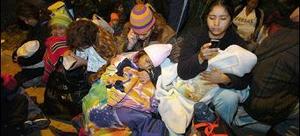More than 827 people were reported injured and the Red Cross said the toll was expected to rise.
Rescue workers struggled to reach the center of the destruction, the port city of Pisco about 125 miles southeast of the capital, Lima. Pisco's mayor said at least 200 people were buried in the rubble of a church where they had been attending a service.
"The dead are scattered by the dozens on the streets," Mayor Juan Mendoza told Lima radio station CPN.
"We don't have lights, water, communications. Most houses have fallen, churches, stores, hotels, everything is destroyed," he said, sobbing.
An AP Television News cameraman who reached the city of Chincha, about 100 miles southeast of Lima, said he counted 30 bodies under bloody sheets on the floor of the badly damaged hospital.
Another church collapsed Wednesday evening in the city of Ica, 165 miles south of Lima, killing 17, according to cable news station Canal N.
The government rushed police, soldiers, doctors and aid to the stricken areas along the coast south of the capital but hundreds of vehicles were paralyzed on the Pan American Highway by giant cracks in the pavement and fallen power lines, the AP Television News cameraman reported from Chincha.
Giorgio Ferrario, head of the Peruvian International Federation of the Red Cross and Red Crescent, said teams from the Peruvian Red Cross arrived in Ica and Pisco after 7 1/2 hours, about three times as long as it would normally have taken because the earthquake had destroyed the roads to these areas.
He said that he expected the death toll to climb as rescue teams worked in the daylight.
News reports said dozens of people in Ica crowded hospitals that suffered cracks and other structural damage. The quake also knocked out telephone and mobile phone service in the capital and to the provinces, making it impossible to communicate with the Ica area.
Electricity also was cut to Ica and smaller towns along the coast south of Lima.
An Associated Press photographer said that some homes had collapsed in the center of Lima and that many people had fled into the streets for safety. The quake shook Lima furiously for more than two minutes.
"This is the strongest earthquake I've ever felt," said Maria Pilar Mena, 47, a sandwich vendor in Lima. "When the quake struck, I thought it would never end."
Antony Falconi, 27, was desperately trying to get public transportation home as hundreds of people milled on the streets flagging down buses in the dark.
"Who isn't going to be frightened?" Falconi said.
"The earth moved differently this time. It made waves and the earth was like jelly."Firefighters were called to put out a fire in a shopping center. Police reported that large boulders shook loose from hills and were blocking the country's Central Highway, which heads east into the Andes mountains.
State doctors called off a national strike that began on Wednesday to handle the emergency. President Alan Garcia also said public schools would be closed Thursday because the buildings may be unsafe.
The Civil Defense death toll of 337 first appeared on its Web site, but the organization's spokesman, Dario Ariola, refused to confirm the figure, which was much higher than the numbers provided by the health minister. But minutes later Civil Defense Commander Aristides Mussio confirmed the toll on Peru's state television station, saying one person was killed in Lima and 336 in the region of Ica.
The U.S. Geological Survey said Wednesday's earthquake hit at 6:40 p.m. about 90 miles southeast of Lima at a depth of about 25 miles. Four strong aftershocks ranging from magnitudes of 5.4 to 5.9 were felt afterward.
The Hawaii-based Pacific Tsunami Warning Center issued a tsunami warning for the coasts of Peru, Chile, Ecuador, Colombia, Costa Rica and Panama. A tsunami watch was issued for the rest of Central America and Mexico and an advisory for Hawaii.
The center canceled all the alerts after about two hours, but it said the quake had caused an estimated 10-inch tsunami near the epicenter.
The last time a quake of magnitude 7.0 or larger struck Peru was in September 2005, when a 7.5-magnitude earthquake rocked the country's northern jungle, killing four people. In 2001, a 7.9-magnitude quake struck near the southern Andean city of Arequipa, killing 71 people.
The region sits on two plates that are constantly shifting and Thursday's earthquake, like most earthquakes in the area, occurred when one plate dove under the other quickly, according to Amy Vaughan, a USGS geophysicist at the National Earthquake Information Center in Golden, Colo.
The plates are always "moving slowly, but this was a sudden shift," Vaughan said.
Some of the world's biggest quakes, including the catastrophic Indian Ocean temblor in 2004 that generated deadly tsunami waves, are caused by a similar movement of plates.
___
AP Writer Monte Hayes reported from Lima, Peru. Associated Press writers Leslie Josephs in Lima, Alicia Chang in Los Angeles and Sarah DiLorenzo in New York contributed to this report.




Reader Comments
to our Newsletter